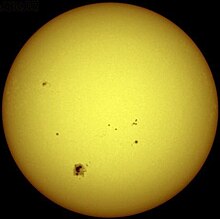Solar cycle 12: Difference between revisions
Appearance
Content deleted Content added
m Correct caps in section headers (and GFs). Problems? Come to my my talk page. |
No edit summary |
||
| Line 1: | Line 1: | ||
[[File:Sun920607.jpg|thumb|right|The Sun with some sunspots visible.]] |
[[File:Sun920607.jpg|thumb|right|The Sun with some sunspots visible.]] |
||
'''Solar cycle 12''' is the twelfth [[solar cycle]] since 1755, when recording of solar [[sunspot]] activity began.<ref name="Kane">Kane, R.P. (2002). "[http://www.springerlink.com/content/qtq52nl8vtq7w2t6/ Some Implications Using the Group Sunspot Number Reconstruction]". ''Solar Physics'' '''205(2)''', 383-401.</ref><ref name=SpaceToday>{{cite web | title=The Sun: Did You Say the Sun Has Spots? | url=http://www.spacetoday.org/SolSys/Sun/Sunspots.html | publisher=Space Today Online | accessdate=12 August 2010}}</ref> The solar cycle lasted 11.3 years, beginning in December 1878 and ending in March 1890. The maximum smoothed sunspot number (monthly number of sunspots averaged over a twelve month period) observed during the solar cycle was 74.6, and the minimum was 5.<ref name="SIDC Monthly Smoothed Sunspot Number">SIDC Monthly Smoothed Sunspot Number. "[http://sidc.oma.be/sunspot-data/]"</ref> There were a total of approximately 736 days with no sunspots during this cycle.<ref name="Spotless Days">Spotless Days. "[http://spaceweather.com/glossary/spotlessdays.htm?PHPSESSID=dli444kmrjgre0rjq6l86fv144]"</ref><ref name="What's Wrong with the Sun? (Nothing)">What's Wrong with the Sun? (Nothing) more information: Spotless Days. "[http://science.nasa.gov/headlines/y2008/11jul_solarcycleupdate.htm]"</ref><ref name="Solaemon's Spotless Days Page">Solaemon's Spotless Days Page. "[http://users.telenet.be/j.janssens/Spotless/Spotless.html]"</ref> |
'''Solar cycle 12''' is the twelfth [[solar cycle]] since 1755, when recording of solar [[sunspot]] activity began.<ref name="Kane">Kane, R.P. (2002). "[http://www.springerlink.com/content/qtq52nl8vtq7w2t6/ Some Implications Using the Group Sunspot Number Reconstruction]". ''Solar Physics'' '''205(2)''', 383-401.</ref><ref name=SpaceToday>{{cite web | title=The Sun: Did You Say the Sun Has Spots? | url=http://www.spacetoday.org/SolSys/Sun/Sunspots.html | publisher=Space Today Online | accessdate=12 August 2010}}</ref> The solar cycle lasted 11.3 years, beginning in December 1878 and ending in March 1890. The maximum smoothed sunspot number (monthly number of sunspots averaged over a twelve month period) observed during the solar cycle was 74.6, and the minimum was 5.<ref name="SIDC Monthly Smoothed Sunspot Number">SIDC Monthly Smoothed Sunspot Number. "[http://sidc.oma.be/sunspot-data/]"</ref> There were a total of approximately 736 days with no sunspots during this cycle.<ref name="Spotless Days">Spotless Days. "[http://spaceweather.com/glossary/spotlessdays.htm?PHPSESSID=dli444kmrjgre0rjq6l86fv144]"</ref><ref name="What's Wrong with the Sun? (Nothing)">What's Wrong with the Sun? (Nothing) more information: Spotless Days. "[http://science.nasa.gov/headlines/y2008/11jul_solarcycleupdate.htm]"</ref><ref name="Solaemon's Spotless Days Page">Solaemon's Spotless Days Page. "[http://users.telenet.be/j.janssens/Spotless/Spotless.html]"</ref> A very bright blood-red aurora display happened over New York in April 16, 1882, while significant communication disturbances occured.<ref>http://www.solarstorms.org/SRefStorms.html</ref> |
||
==See also== |
==See also== |
||
Revision as of 10:53, 29 October 2010

Solar cycle 12 is the twelfth solar cycle since 1755, when recording of solar sunspot activity began.[1][2] The solar cycle lasted 11.3 years, beginning in December 1878 and ending in March 1890. The maximum smoothed sunspot number (monthly number of sunspots averaged over a twelve month period) observed during the solar cycle was 74.6, and the minimum was 5.[3] There were a total of approximately 736 days with no sunspots during this cycle.[4][5][6] A very bright blood-red aurora display happened over New York in April 16, 1882, while significant communication disturbances occured.[7]
See also
References
- ^ Kane, R.P. (2002). "Some Implications Using the Group Sunspot Number Reconstruction". Solar Physics 205(2), 383-401.
- ^ "The Sun: Did You Say the Sun Has Spots?". Space Today Online. Retrieved 12 August 2010.
- ^ SIDC Monthly Smoothed Sunspot Number. "[1]"
- ^ Spotless Days. "[2]"
- ^ What's Wrong with the Sun? (Nothing) more information: Spotless Days. "[3]"
- ^ Solaemon's Spotless Days Page. "[4]"
- ^ http://www.solarstorms.org/SRefStorms.html
